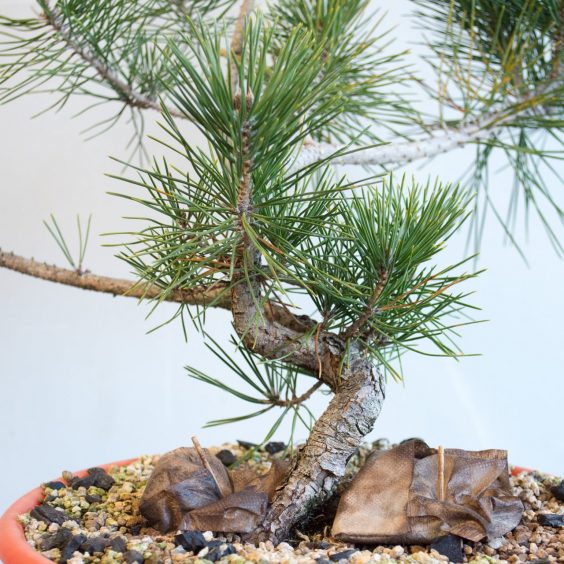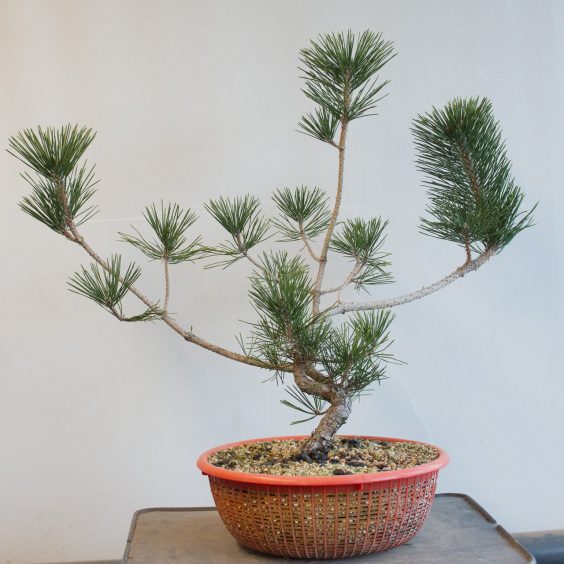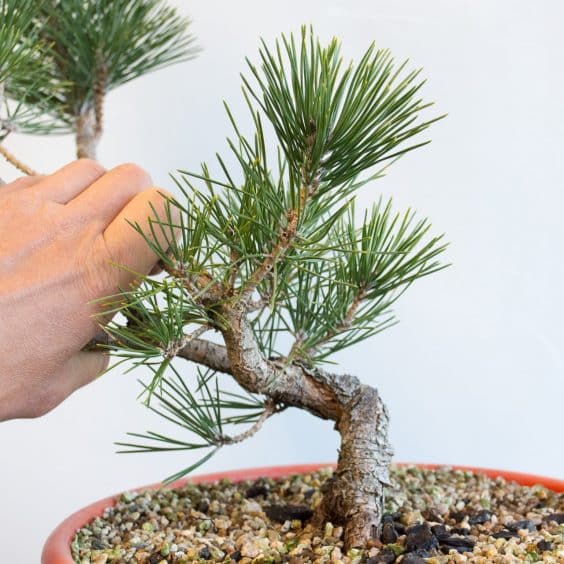One of the most common questions I hear relating to the development of pine bonsai has to do with the lower branches: What should I do with them?
The answer is fairly simple – keep them. There are, however, some details that may come in handy. Let’s look at an example.
The pine below is almost five years old from seed. The lower part of the trunk was wired in year two. The tree has grown freely since then.
5 year old black pine
The three long, rangy branches are sacrifice branches. They will stick around to help the trunk thicken and be removed when the trunk reaches the desired size. The final tree will be much smaller.
Close-up of the lower trunk suggesting the future size of the tree
As you can see in the photo above, there are a number of small branches about 3″-6″ from the base of the trunk. These branches will be used to create the primary branches in the final design. For the time being, I’m letting these branches grow slowly for use later.
When everything goes according to plan, these lower branches will continue to grow slowly and remain perfectly healthy for the next five years until it’s time to focus on developing the silhouette. Needless to say, this is rarely the case. Fortunately, there are some approaches to maintaining these branches for use later.
- If the lower branches get too strong, they can be decandled. I rarely find the need to do this as letting sacrifice branches grow freely encourages the tree to invest most of its energy up high as these branches get the most light.
- If the lower branches get too weak, the sacrifice branches can be decandled. Decandling the sacrifice branches can do a lot to encourage the tree to invest in the lower branches which can help keep them healthy.
Where do these branches come from in the first place? For the most part, they simply appear in years 2-4, especially if the tree is wired or pruned at this time. The tendency to produce branches along the trunk declines as pines mature.
What if the lower branches die or don’t grow in the first place?
- If small branches don’t show up, cutting back can stimulate new buds as long as there are needles on the trunk.
- If a tree with no lower branches isn’t cutback or the lower branches die at some point, grafting can be a good option for improving ramification.
After bringing the above tree into the workshop for photos, I did a little maintenance. I removed most of the old, and some of the new, needles, and thinned a few shoots on the sacrifice branches to open up crowded areas.
After removing old needles and thinning crowded areas
As you can see from the photo below, the lower part of the tree looks mostly the same.
After removing some old needles – the sacrifice branches on the left will be removed later
And that’s it for this season. I’ll take another look at the tree in the middle of next year to see if additional work is needed.
Subscribe to Bonsai Tonight
New Posts Delivered Every Tuesday and Friday




Cesar says
I live in Florida, and I have a 6 yeard old JBP that needs to be repotted as well as a Junpier. What time of year would be best to perform this?
Jonas Dupuich says
I’d check with local enthusiasts to find out the best time to repot your trees, but I’d imagine a good time would be right before the pine starts sending out new growth in spring.
Neil Pointer says
When is a good season to graft the lower branches? I was given a four year old pine, I grafted in September. I used parafilm grafting tape to wrap the scions and graft them. I wonder if they will survive till spring! The needles of scions still have deep green color looking through the tape. Any help, pointers ideas you can give me will be fantastic.
Neil
Jonas Dupuich says
A great time for grafting pines is the beginning of spring, right before the trees start growing after winter dormancy. That said, pines can be grafted throughout the dormant season, though care must be taken to protect tree and scion from freezing.
Since the graft is done, the main thing now is after care, including leaving the tape in place until the new shoot pushes its way through.